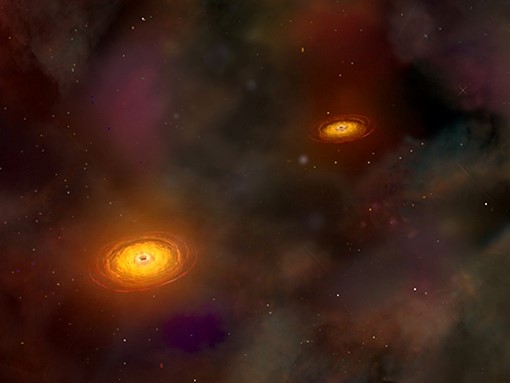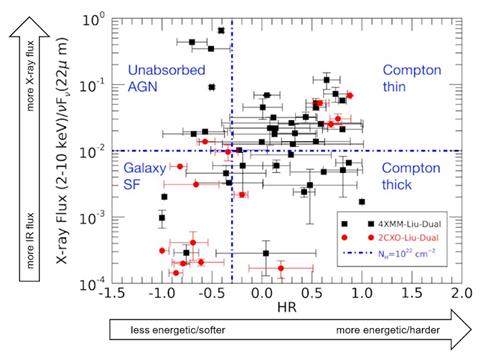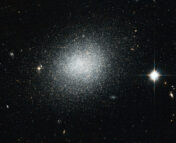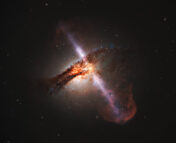Title: The X-ray view of optically selected dual AGN
Authors: A. De Rosa, C. Vignali, P. Severgnini, S. Bianchi, T. Bogdanović, M. Charisi, M Guainazzi, Z. Haiman, S. Komossa, Z. Paragi, M. Perez-Torres, E. Piconcelli, L. Ducci, M. Parvatikar, & R. Serafinelli
First Author’s Institution: Insituto Nazionale di Astrofisica (INAF), Instituto di Astrofisica e Planetologia Spaziali (IAPS), via Fosso del Cavaliere, Roma I-133, Italy
Status: Accepted to MNRAS [open access]
The supermassive black holes(SMBHs) at the centers of galaxies are the Universe’s most massive objects, and if they’re fed gas, they can become incredibly bright, outshining all of the stars in their host galaxy. The process of gas spiraling in towards an SMBH is called accretion, and an accreting SMBH is called an active galactic nucleus (AGN). There are many different types of AGN, and each can have a different impact on the evolution of its galactic surroundings.

Galactic evolution is thought to be driven by galaxy mergers, and if each galaxy contains a supermassive black hole we expect to observe a pair of bound AGN, called dual AGN systems. Simulated galaxy mergers can help us predict how dual AGN systems form and evolve, depending on different initial conditions. Ideally, we could compare these results to observational data to see which conditions best match reality. However, the observation of dual AGN systems is very difficult, because AGN are typically far away, meaning that we can rarely view the individual AGN separately. This leads to a fairly small observed sample, making it difficult to draw any conclusions. In order to understand galactic evolution, astronomers need to build up a larger catalog of dual AGN observations that capture dual AGN at multiple stages of the merger process.
The authors of today’s paper put together an impressive sample of 124 AGN. All of the AGN had previously been observed in the optical wavelengths, but now, the authors combine them with X-ray observations to measure their separations, luminosities, and the amount of gas surrounding the AGN. Optical observations of the AGN were drawn from the Sloan Digital Sky Survey (SDSS). The authors then cross-referenced the AGN with data taken by the Chandra X-Ray Observatory and XMM-Newton (two space-based X-ray telescopes). X-ray and optical data was available for 26 systems of dual AGN with separations between the individual SMBHs ranging from 3.4 to 97.2 kiloparsecs.
The authors find that an AGN in a dual system is, on average, more luminous than a single AGN, suggesting that galaxy mergers cause AGN to become more luminous. They additionally find that dual AGN are more likely to be obscured from direct view by intervening gas than single AGN.

From the AGN spectra, the authors calculate a ratio of the systems’ X-ray luminosity and mid-infrared luminosity, as well as X-ray “hardness”. X-ray hardness measures how much energy is emitted at more energetic (“harder”) wavelengths relative to the amount of energy emitted at less energetic (“softer”) wavelengths. The flux ratio and X-ray hardness can be used to calculate how much gas is present along the line of sight (this is known as column density) to the AGN (see Figure 1). If the column density is above a specific value, the AGN is classified as “Compton thick”, and below this value, it’s classified as “Compton thin”. The authors found that 16% of the dual AGN systems were Compton thick, which is a higher rate than what is observed for single AGN. Interestingly, it’s a lower rate than what is observed for dual AGN that are further along in the merging process, suggesting that AGN tend to be more obscured as they evolve.
In order to draw conclusions about dual AGN systems from these observations, the authors had to verify that the gas obscuring the AGN is actually located in the nucleus of the galaxy, rather than further away. Therefore, the authors look at oxygen emission at 5700 Å (0.0005007 mm) in the spectrum. This specific wavelength is known to be produced by oxygen further away from the galactic nucleus. The strength of the emission gives insight into how much obscuring gas the light has passed through on its way to us. If the column density calculated from the emission line is similar to the column calculated from the flux ratio and X-ray hardness, it would suggest that the same gas is causing both effects, which means that the gas is actually not close to the AGN. The authors, however, found a significant difference between the amount of obscuring material predicted by the two different methods, so they can confidently say they’re looking at gas very close to the galactic nucleus.
The findings of today’s paper suggest that as the AGN get closer to each other, they become more luminous and are more likely to be obscured by gas close to the nucleus of the galaxy. Simulations of galaxy mergers find the same relationship between AGN separation and the amount of gas surrounding them, suggesting that these simulations are accurately capturing this aspect of galaxy evolution!
Astrobite edited by Nathalie Korhonen Cuestas
Featured image credit: NASA/CXC/A. Hobart, De Rosa et al., (2022): Figure 2




